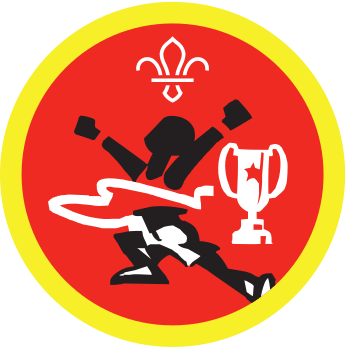The hero’s journey
You’ll need
- Pens or pencils
- Scrap paper
- Stopwatch or phone
- Access to the internet
- Fancy dress items
The hero’s journey: a storytelling structure
In storytelling, The Hero’s Journey is a common template identified by Joseph Campbell in the first half of the twentieth century. This template, typically split into 12 stages, outlines the different phases in a hero’s journey as they are called to adventure, face trials and tribulations, win a victory and return home changed or transformed.
To engage your group with this theme you might pick out some common fictional examples and break down how this format applies to them, like Star Wars, Harry Potter and The Lord of the Rings. See some examples explained in this useful blog post.
Plan your adventure
- Come up with a list of athletic events that everyone in the group can take part in. Those trying for their Athletics Plus Activity Badge will need to complete any three of the events listed here. If different members of the group want to do different things, work this in where possible, as activity bases can always be swapped around if all the equipment and gear you need is ready.
- Source any equipment or gear that young people will need to safely take part and do their best in these events. Encourage young people to bring along any suitable gear they have at home.
- Source an outdoor location where you can hold the events. Have a backup indoor option too, in case of poor weather.
- In the weeks leading up to the session, everyone should work together to come up with a fictional place and time in which to do their athletic events. The person leading the activity should explain to everyone that each athletic event will be run as part of the 'hero’s journey' explained above. Each person taking part should approach the events as though they’re on a quest, like the characters in ‘The Lord of the Rings,’ ‘Star Wars’ and ‘Harry Potter.’ Each event should form a different part of the journey.
- Source any costumes or props you might need for your quest. You could go one step further and commission a member of the group to write a narrative for everyone to follow, using the model of the hero’s journey. The writer will need a copy of the events list, so they can fit each event to a scene.
Run the activity
- Have everyone do a warm-up of all the major muscle groups before starting any events. A young person could lead this, with supervision.
- Set up the athletic event bases that are needed to start the adventure. Make sure each one has the right equipment and any bits of story, costumes or props needed for the quest. Make sure any other bases needed have all their equipment and props ready to go. Have those not taking part help direct everyone, narrate on the progress of the quest and set up the events.
See below for examples of how The hero's journey can be used to add a storytelling structure to your session, with each obstacle, event or activity taking inspiration from one of the 12 stages.
Step by step
The ordinary world is where your heroes live. Everyone should gather together here after the bases are set up and everyone has done a warm-up.
In the story, this could see everyone tending their farms or sailing their boats, with appropriate actions to keep everyone moving.
There has been a call to adventure. Everyone should gather at the base of an athletic event they don’t enjoy so much. Discuss in these groups how prepared everyone feels for the challenges ahead and how they can keep going when it gets tough.
At this stage, it might be helpful to have as many bases set up as you have helpers (five should be enough), so everyone can be easily supervised.
This is where the heroes turn down the chance of an adventure because of fears or doubts. In the same groups and base as stage 2, everyone should discuss how they can help everyone feel comfortable and included in events such as these. Everyone can then support one another to have a go at the athletic event they don’t enjoy, to see if this support makes the challenge any easier.
The mentor is there to guide and inspire the heroes. Everyone should move to another base featuring an event they haven’t tried before, or the one they have the least experience with. Supporting one another, everyone should have a few attempts at the event and see if they can improve their time/distance/score.
The fifth stage of the quest is crossing the threshold at the start of the challenge. With a goal in mind, everyone should visit the remaining athletic event bases.
Those attempting the Athletics Plus Activity Badge will need to have their times, distances or scores recorded. This could be done by a young person not taking part in the challenge. You may need to set up more bases at this point.
The sixth stage of the quest is encountering tests, allies and enemies. Overcoming obstacles means working on your jumping skills! Have those taking part team up with an ally and take on an event like long jump, high jump or triple jump, if you have suitable equipment set up and appropriate supervision. Those who’ve already jumped should team up and try something like 100m hurdles or a standing jump. Allies should support one another and record the size of the jumps/times.
The seventh stage of the quest is the approach to the inmost cave. This is the place where the main conflict of the story takes place. At this point, someone’s bound to be chasing after you! Everyone should take part in a 100m, 200m or 400m race to get away.
The eighth stage of the quest is the ordeal, which is the main conflict in the inmost cave. It’s time for everyone to throw everything they have at this! Line up for shot or discus throwing, if you have the necessary equipment and appropriate supervision. Use an ordinary tennis ball otherwise. Extra points for distance!
The ordeal should be a transformative experience, so this might be a good time for a costume change, for those taking part to switch groups or partners, or for some other change dreamed up by your narrator! This will need to be risk assessed beforehand. Make sure costumes don’t prevent anyone from taking part safely.
The ninth stage of the quest is the reward or prize for defeating the baddie. Present your victorious heroes with the mystical cricket ball, or some other trophy, and allow everyone some time to take a well-earned breather.
The road back to the ordinary world is often long and tiring. Everyone should line up for an 800m or 1500m race, after another quick warm-up. It’s a long way home!
The eleventh stage of the quest is the resurrection or rebirth of the heroes. With all they’ve experienced, they should have picked up some new skills or seen things in a different way. See if anyone would like to try an event again that they didn’t enjoy or didn’t get a chance to do at the beginning.
The twelfth stage of the quest is returning home. Everyone should hold aloft their cricket ball in triumph. There’s one last test before they can return to their farms and boats. Everyone should bowl the cricket ball as far as they can. Extra points for technique and distance.
At this point, everyone will need a good cool-down. Doing the farming and boating motions from before could be part of this, as the heroes return to their ordinary lives.
Reflection
This was a very different way to think about a sporty challenge. Everyone had to play their role in the story, and keep on top of the athletics events. Did this make anyone enjoy an event more than they thought they would? Did the story element make these events more or less fun? Why might this kind of activity be more inclusive than a typical school sports day?
Safety
All activities must be safely managed. You must complete a thorough risk assessment and take appropriate steps to reduce risk. Use the safety checklist to help you plan and risk assess your activity. Always get approval for the activity, and have suitable supervision and an InTouch process.
- Active games
The game area should be free of hazards. Explain the rules of the game clearly and have a clear way to communicate that the game must stop when needed. Take a look at our guidance on running active games safely.
There are lots of elements to the hero’s journey that can be added or taken out to make this challenge easier or harder. In the same way, there are lots of athletics events that can be added or taken out.
- For more information on inclusivity in athletic events, check out this information from England Athletics.
All Scout activities should be inclusive and accessible.
If everyone enjoyed playing their role in the story, why not add this creative element to other activities and see what happens? Anyone trying for their Writer Activity Badge or keen creative writers will be thrilled!
Young people shaped all aspects of this challenge, from the events that were contested to the plot of the story. They both created and became heroes.


